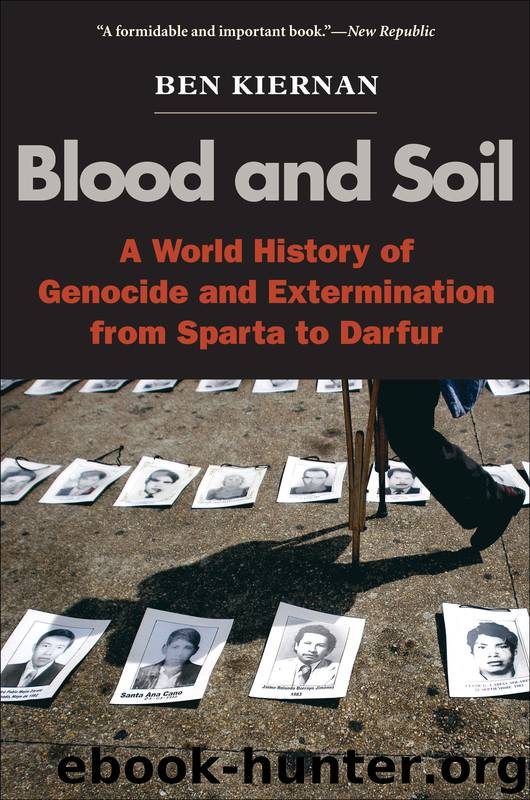Blood and Soil by Ben Kiernan

Author:Ben Kiernan
Language: eng
Format: epub
Publisher: Yale University Press
Published: 2007-02-22T16:00:00+00:00
Historical Background to the Armenian Genocide
In the fourth century C.E., the mountain monarchy of Armenia, occupying much of eastern Anatolia, was arguably the first nation to adopt Christianity. Muslim armies overran the last Armenian kingdom of Cilicia in 1375. Turks incorporated most of the Armenian lands in the sixteenth century, as the Ottoman Empire reached its height, conquering Egypt, Syria, and Iraq. But successive Turkish defeats, including that at Vienna in 1683, finally halted Ottoman expansion. Now, fear of decline preoccupied Ottoman strategists. As early as 1625, for instance, courtiers warned that if European traders gained access to the Yemeni coastal trade, “before very long, the Europeans will rule over the lands of Islam.” After humiliating treaties with Western powers in 1699 and 1718, Ottoman statesmen, historian Bernard Lewis writes, “discussed with brutal frankness the decrepit state of the Empire and the abject performance of its armies.”4
First Persia occupied the eastern part of historic Armenia, then Russia annexed it. Russia also won the right to intervene in the Ottoman Empire to protect the rest of the Armenians and other Christians remaining within it. In 1821, the outbreak of the Greek revolution and war of independence heralded a century of further Ottoman imperial retrenchments.5 Although an adviser warned the sultan, “[L]et us not cede an inch of our territory,” Greece became independent in 1828. Five years later, Russia gained “a privileged right of protectorship over Turkey,” which ended only after Ottoman reforms of 1839 and 1856 had conceded “the principle of equality of non-Muslims.” The sultan now had to demonstrate “generous intentions towards the Christian populations of his Empire.”6
Ottoman society was traditionally divided into ethnoreligious communities known as millets—Muslim, Jewish, Greek Orthodox, and Armenian. As the historian Richard Hovannisian describes it, “The millet system allowed the Armenians to retain their cultural-religious identity in a plural society, but it rendered them powerless politically and militarily.” Until 1876, the Ottoman sultanate, known as the Sublime Porte, barely implemented the externally imposed reforms to protect Christians. But their formal acceptance had established a link between imperial retreat and rights for internal Christian minorities. When communal violence erupted in Lebanon and Syria in 1860, with Muslims and Druzes massacring 40,000 Maronite Christians, the Porte reacted quickly by executing 167 culprits in Damascus. Yet this failed to stop a 6,000-strong French expeditionary force landing in Beirut and imposing an agreement on “protecting the Christians.” An 1874 Ottoman financial collapse was followed by uprisings in Bosnia and Herzegovina and other revolts by Bulgarians, Serbs, and Montenegrins. Turkish forces slaughtered as many as 15,000 Bulgarian civilians in May 1876.7
At that point, the Ottoman Empire still dominated the Balkans and arguably even remained the largest European power on the African continent.8 Then the “Scramble for Africa,” in which the other metropolitan empires colonized the continent by 1900, coincided with a new rash of disastrous Ottoman losses both there and in Europe: the Russo-Turkish war of 1877–78, the Anglo-French displacement of Turkish overlordship in Egypt in 1879, and the 1896 Cretan insurrection and Greco-Turkish war leading to the Turkish evacuation of Crete in 1898.
Download
This site does not store any files on its server. We only index and link to content provided by other sites. Please contact the content providers to delete copyright contents if any and email us, we'll remove relevant links or contents immediately.
Cecilia; Or, Memoirs of an Heiress — Volume 1 by Fanny Burney(31341)
Cecilia; Or, Memoirs of an Heiress — Volume 3 by Fanny Burney(30938)
Cecilia; Or, Memoirs of an Heiress — Volume 2 by Fanny Burney(30896)
The Great Music City by Andrea Baker(21472)
We're Going to Need More Wine by Gabrielle Union(18081)
Bombshells: Glamour Girls of a Lifetime by Sullivan Steve(13117)
Pimp by Iceberg Slim(12939)
All the Missing Girls by Megan Miranda(12761)
Fifty Shades Freed by E L James(12453)
Talking to Strangers by Malcolm Gladwell(11899)
Norse Mythology by Gaiman Neil(11893)
Crazy Rich Asians by Kevin Kwan(8357)
Mindhunter: Inside the FBI's Elite Serial Crime Unit by John E. Douglas & Mark Olshaker(7844)
The Lost Art of Listening by Michael P. Nichols(6480)
Enlightenment Now: The Case for Reason, Science, Humanism, and Progress by Steven Pinker(6411)
Bad Blood by John Carreyrou(5778)
The Four Agreements by Don Miguel Ruiz(5519)
Weapons of Math Destruction by Cathy O'Neil(5045)
We Need to Talk by Celeste Headlee(4876)
